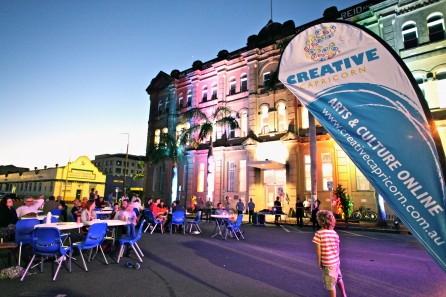
Creative Capricorn was a three-year cultural program rolled out in Rockhampton, Queensland. Its aim was to demonstrate that when integrated into economics, social and community planning, arts and cultural projects can assist in the diversification of local economies, increase social cohesion and improve quality of life for the community.
NSF was commissioned to evaluate this program over its three year period and beyond, to explore any evidence of longer term impacts on the community. It was a long, rewarding, challenging and enduring process. The final evaluation report has just been published by Arts Queensland (see it here). It will no doubt provide insights for the wider cultural sector to inform the design of future initiatives.
Creative Capricorn achieved its intended objectives to varying degrees. But it also experienced challenges, many of which were unique to the setting and time, others that may apply more broadly to the regional cultural sector.
Rationale for selecting Rockhampton
Despite Rockhampton being identified by federal and state government as a region that had potential to benefit from booted arts investment, it became clear that the kinds of objectives the federal government attached to the initiative did not align with the needs and priorities of Rockhampton at that point in time. This highlights the need for a fuller needs assessment to be carried out before deciding to invest in a region. Had this occurred it would have indicated that Rockhampton was not the right choice for the ambitious outcomes sought through Creative Capricorn.
Project scope
The project brief development by government included broad objectives that seemed to align with the European Cities of Culture model, which were unrealistic for the city of Rockhampton, and not endorsed by the community.
Lack of endorsement from local government
Rockhampton Regional Council’s elected members did not actively support or endorse Creative Capricorn, or demonstrate an understanding of the potential benefits of the program. Consequently, the project did not reach its full potential, nor did it attract the business support or investment it may otherwise have realised. Transition planning was not effectively carried through.
External influences
A number of external factors impacted on the effective delivery of Creative Capricorn. They included the de-amalgamation of Rockhampton and Livingstone Shire Councils in the course of the program, local government elections, and state government elections. Although they could not have been anticipated, they may have been better mitigated through stronger governance and administrative systems to reduce their detrimental impact on the program.
Governance and administration
Over time, a number of governance and administration issues arose that impacted on the efficiency with which the program was delivered, creating delays and change in timeframes.
Model of delivery
The program was delivered using a Fly-In-Fly-Out (FIFO) model. The model weakened the capacity for the program to be seen as locally relevant and therefore embraced by the community. Consequently, opportunities to create networks and connections were not fully realised, which impacted on the extent to which outcomes could be readily achieved.
Branding
Although awareness of Creative Capricorn increased over time, there were issues relating to branding that impacted on the program reaching its full potential.
Minimal financial backing
Despite efforts made to approach a range of business sectors for support and sponsorship, limited support was received. This impacted on resources available to deliver the initiative and therefore the effectiveness of the program in its generation of desired outcomes.
Given these challenges, Creative Capricorn demonstrated that concentrated investment in a region with low levels of engagement and capacity can effectively bring about positive change. The ambitious objectives of Creative Capricorn were not an appropriate match with the needs of the Rockhampton community. However, the work achieved by Creative Regions Ltd in the rollout of the program under these challenging circumstances, resulted in the creation of considerable changes to the lives of a small number, and modest changes to the broader community.
The lessons learned from this pilot initiative can be carried forward into the planning of future arts and cultural programs designed to contribute to cultural vibrancy in regional communities.
Image: Tom Hearn
